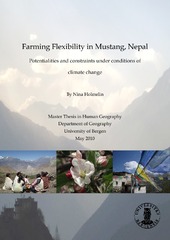Farming Flexibility in Mustang, Nepal. Potentialities and constraints under conditions of climate change
Master thesis
Permanent lenke
https://hdl.handle.net/1956/3983Utgivelsesdato
2010-05Metadata
Vis full innførselSamlinger
- Department of Geography [676]
Sammendrag
Climate change is projected to involve rising average temperatures and more rapid melting ofice and snow in the Himalaya. Increased seasonality in river discharge and substantialreductions in regional food production are probable consequences from these changes. Theneed is thus present to investigate the potentials for local agricultural production in the face ofclimate change. In the highly diverse Himalayan region, however, climate projections at thelocal scale are rather uncertain. Therefore, people’s ability to maintain local agriculturalproduction will probably depend on how flexible the local farming systems are to adjust tounpredictable changes, particularly in temperature and water availability.The objective of this thesis is to study the flexibility of one such farming system which islocated in Mustang, Nepal Himalaya. Defining flexibility as ‘uncommitted potentialities forchange’, the thesis identifies opportunities for change in the farming system, as well as factorsthat constrain this flexibility. Further developing the concept of flexibility, it is suggested thatflexibility may be analysed in terms of type, scope and temporal flexibility. Although thereare several underexploited resources in the studied farming system, the present situation is notregarded as one of irrational and suboptimal exploitation of resources. Instead, unexploitedresources imply opportunities for change, which provide the system with flexibility to rapidlyadjust agricultural production to varying weather conditions. However, there are limits toflexibility. In an interlinked farming system, lack of one resource, such as water for irrigation,may constrain the general performance of the system. Still, as long as the seasonal availabilityof irrigation water is not drastically altered or reduced, the farming system is probably flexibleenough to enable people to increase their reliance on local agricultural production also in theyears to come.
Utgiver
The University of BergenOpphavsrett
The authorCopyright the author. All rights reserved
